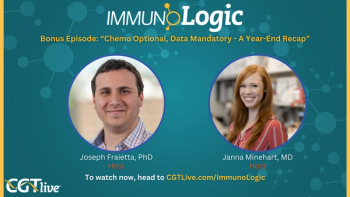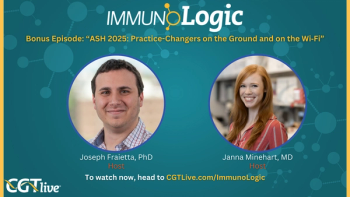
Research on CAR T Therapy in Earlier Lines of Treatment
Amit Patel, BSc, MBBS, PhD, discusses currently ongoing clinical trials of CAR T-cell therapy in first- and second-line treatment settings and comments on potential developments on the horizon.
Amit Patel, BSc, MBBS, PhD: Currently we have autologous CAR [chimeric antigen receptor] T-cell therapy in the third-line space for DLBCL [diffuse large B-cell lymphoma]. There are clinical trials ongoing investigating the question of CAR T therapy in the second-line setting compared with platinum-based salvage with or without an autologous stem cell transplant. We should have results from these studies in the next 12 months or so.
What’s tantalizing though is that the ZUMA-12 study showed us the proof of concept of first-line autologous CAR T therapy. These patients had initially been treated with chemoimmunotherapy with rituximab and CHOP [cyclophosphamide, hydroxydaunorubicin hydrochloride, vincristine, prednisone], and those patients who, on an interim assessment, had not achieved an adequate response could then go on to have an autologous stem cell harvest followed by CAR T therapy. That’s an important consideration for high-risk-patient groups in the first-line setting.
For patients who we think will have poorer outcomes, and these were identified based on response, we may be able to identify some patients at baseline who would be expected to have a worse outcome—for example, double- or triple-hit patients or TP53-mutated patients and others. Of course, these patients have a better autologous harvest when we collect their cells prior to manufacture of a CAR T-cell product, which is enriched with more naїve cells and therefore a more favorable product characteristic. We know that they have very high response rates and complete remission rates. We also know that they have higher-peak CAR T expansion levels in the first month, and we know that they have a higher total area under the curve in the first month—2 parameters associated with response.
There are data confirming proof of concept of the approach of using CAR T therapy as part of first-line treatment in high-risk patients, and that’s the destination of travel. However, we’ve got a few steps to overcome before we get there. One of those is demonstrating superiority to conventional second-line therapy, based on the ongoing clinical trials for axicabtagene ciloleucel, tisagenlecleucel, and lisocabtagene, which is currently unlicensed in Europe.
In terms of the future landscape for autologous CAR T therapy, a number of developments of the product are underway. One of them is multitargeting to deal with CD19 escape or downregulation. Another has to do with manufacture and time to manufacture, and processes are also underway to reduce the time to manufacture to a couple of days. The third is really looking at allogeneic donor sources for CAR T therapies, and these are important areas of development where we’ve seen some early data presented at EBMT [European Society for Blood and Marrow Transplantation Annual Meeting] and at other conferences over the last year.
TRANSCRIPT EDITED FOR CLARITY
Newsletter
Stay at the forefront of cutting-edge science with CGT—your direct line to expert insights, breakthrough data, and real-time coverage of the latest advancements in cell and gene therapy.





































